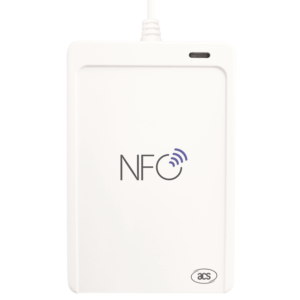Table of Contents
ToggleIntroduction
Radio Frequency Identification (RFID) technology represents a form of contactless automatic identification that leverages the transmission properties of radio waves. Through methods such as inductive or electromagnetic coupling and radar reflection, RFID systems are capable of automatically recognizing objects. This robust technology has found widespread application across diverse industries thanks to its efficiency, speed, and the ability to handle multiple tags simultaneously. This article delves into the intricacies of RFID readers, exploring their types, applications, and the overarching benefits they bring to various sectors.

The Basics of RFID Readers
RFID readers are a pivotal element of the RFID system. These devices autonomously identify target objects and collect essential data through RFID signals without the need for manual input. Due to their capability to handle fast-moving objects and multiple RFID tags at once, RFID readers stand out for their operational speed and convenience. Essentially, an RFID reader serves as a communication hub within the RFID system, transmitting and receiving radio waves to interact with RFID tags. This interaction is fundamental for item tracking, data exchange, and ensuring efficient operation of the entire RFID network.
Fixed RFID Readers
Fixed RFID readers are typically equipped with between 1 and 8 antenna ports. The required number of antennas depends on the coverage needs of the particular RFID application. For instance, applications that necessitate a small coverage area, such as file management systems, can operate adequately with a single antenna. On the other hand, applications requiring broader coverage areas often need multiple antennas to achieve the necessary reach and reliability.
- Example Applications:
- Warehouse Management: Tracking the location and status of inventory.
- Retail: Monitoring product movement and ensuring proper stock levels.
- Manufacturing: Managing production lines and assembly processes.
Handheld RFID Readers
Handheld RFID readers are portable devices that can interface with hosts or smart devices while reading RFID tags. Due to their lightweight, battery-operated design, handheld readers are highly mobile and can be utilized in various locations without the necessity for installation. These readers operate by simply being activated to read the RFID tags in proximity. Handheld RFID readers also generally entail a lower initial investment compared to fixed readers and offer more diverse application scenarios along with a variety of data collection functionalities.
- Example Applications:
- Inventory Audits: Allowing staff to perform quick and accurate stock counts.
- Field Service: Providing technicians with the ability to scan equipment for maintenance purposes.
- Event Management: Facilitating attendee tracking at large events.
Applications of RFID Readers
RFID technology is employed across a plethora of industries, each finding unique advantages in its application:
- Inventory Management: RFID readers streamline stock monitoring, reducing discrepancies and enhancing inventory accuracy.
- Asset Tracking: Companies can maintain real-time visibility of their assets, improving asset utilization and reducing losses.
- Personnel Tracking: RFID badges facilitate real-time tracking of personnel, ensuring safety and security within premises.
- Controlled Access to Restricted Areas: RFID readers help manage and monitor access to secured areas, ensuring only authorized personnel can enter.
- Supply Chain Management: Enhanced traceability and visibility across supply chains lead to improved efficiencies and reduced errors.
- Anti-Counterfeiting: Particularly in the pharmaceutical industry, RFID technology combats counterfeit products, ensuring authenticity and safety.
Real-Life Examples:
- Pharmaceuticals: Ensuring the authenticity of medications and preventing counterfeit drugs from entering the supply chain.
- Retail: Preventing theft and managing inventory in large retail environments.
- Logistics: Tracking shipments in real-time to provide accurate delivery estimates and reduce losses.
The Future of RFID Readers
The evolution of RFID technology is set to continue, driven by ongoing advancements in reader devices and tag design. Future developments may include increased read ranges, enhanced data processing capabilities, and further integration with other technologies such as IoT (Internet of Things), artificial intelligence, and blockchain. These innovations will likely expand the utility and efficiency of RFID systems, opening up new possibilities for automation, data analytics, and security in various sectors.
- Enhanced Data Processing: Future RFID readers may come equipped with more powerful processing units to handle larger volumes of data rapidly.
- Integration with IoT: RFID systems will seamlessly integrate with IoT networks, enabling real-time data collection and analysis.
- Artificial Intelligence: AI algorithms could provide advanced analytics capabilities, offering predictive insights based on RFID data.
- Blockchain Integration: Inclusion of blockchain can enhance data security and transparency within RFID systems.
Conclusion
RFID readers, whether fixed or handheld, are indispensable in modern identification systems that automate the recognition and tracking of objects. They cater to numerous industries with diverse applications, delivering substantial benefits in terms of efficiency, accuracy, and security. The adoption of RFID technology continues to transform operational processes, ensuring reliable and swift solutions for identification and tracking. As RFID technology evolves, its integration with emerging technologies promises to further enhance its capabilities and applications, solidifying its role as a cornerstone of automated identification systems.
